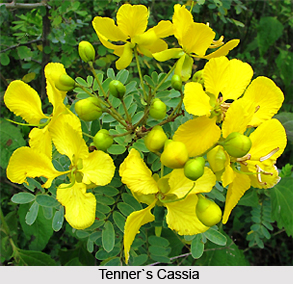 Tenner`s Cassia is well admired in the alternative medicines for its wide usage in Ayurveda, Naturopathy and Herbal therapy. This is a perennial shrub, growing to a height of 30 to 60 cm. It has a circular, solid and strong stem, brown in colour, with several branches. It has compound, stipulate leaves, yellowish green in colour and huge yellow flowers. The fruit of Tenner`s Cassia contains 7 to 10 seeds.
Tenner`s Cassia is well admired in the alternative medicines for its wide usage in Ayurveda, Naturopathy and Herbal therapy. This is a perennial shrub, growing to a height of 30 to 60 cm. It has a circular, solid and strong stem, brown in colour, with several branches. It has compound, stipulate leaves, yellowish green in colour and huge yellow flowers. The fruit of Tenner`s Cassia contains 7 to 10 seeds.
The plant is called `Tenner`s Cassia`, because the bark is one of the most priceless of Indian tans, containing tannin. This plant is extensively cultivated in area which is dry and warm. In India it is found in western region like that of Rajasthan, Maharashtra, Madhya Pradesh and Gujarat.
Tenner`s Cassia belongs to the Magnoliopsida class and is from Rutaceae family. It is of Aurantifolia species. This herbal plant is known as Cassia auriculata in botanical science. Though it is popularly known as `Tarwar` in India, in Sanskrit it is called `Aavartaki` or `Chrama Ranga`, `Aawal` or `Awala` in Gujarati, `Awal` or `Tarwar` in Hindi, `Tarod` or `Tarwad` in Marathi, `Avaraim` or `Avirai` in Tamil, `Avaram` in Malayalam, `Avarikke` or `Tangedi` in Kannada and `Tagedu` in Telugu.
According to Ayurveda, Tenner`s Cassia contains Gunna (properties), laghu (light) and ruksh (dry), Rasa (taste), kashaya (astringent) and tickta (bitter), Virya (potency) and sheet (cold). The bark, seeds and flower of the plant are used for treating diseases and preparing decoction out of it. The pericarp of Tenner`s Cassia has some definite essential oils that contain limonene, beta-pinene, citral and fenchone. Certain aromatics compounds are also seen like terpinol, bisabolene and other kinds of terpenoids and the bark of the plant contains 18 % tannins. As per the practitioners of Ayurveda, Herbal therapy and Naturopathy, Tenner`s Cassia is `kapha` and `pitta dosha` suppressant. Its main role is to bind the cells in the body. It is also a good vermicide and is helpful in coagulation of blood. It also checks the flow of extra amount of urine and helps in absorption of required amount of fluids in the kidneys and intestines. The properties of the plant help in increasing the density of the sperms and is widely used in premature ejaculation. It plays a great role in menstrual disturbances and also prevents vaginal discharge. It is also effective in skin related problems.
The powder of Tenner`s Cassia seeds is applied in the eyes for cataract and improving the general condition of eyes. The bark of the plant is useful in checking secretion or haemorrhage. The leaves act as a revitaliser. They alleviate feverishness and create a feeling of coolness. They also reinstate the perturbed processes of nutrition. The leaves and petals are both moderately astringent in taste. The leaves contain minute amounts of mucilage, though they are absolutely non-toxic; the taste and smell are unappetising. A combination of the leaves forms a refreshing drink. Its seeds also induce a chilling effect.
Often the juice from the flower of Tenner`s Cassia is used in the conditions like premature ejaculation, decreased sperm count and impotence. Even the decoction of whole plant is used in skin related ailments and worm infestation. It is also used as female tonic in menstrual disturbances and leucorrhea. This plant is well known for its healing power and curative properties and is useful in arresting secretion or bleeding. They also restore the disordered processes of nutrition. Even this plant is used to be effective in numerous cases like, diabetes, conjunctivitis, aching throat, troubled menstruation, opthalmia, also arresting bleeding. Even diseases like diarrhea and dysentery can be cured by the plant.
Tenner`s Cassia is also useful in diabetes. A decoction of the entire plant or buds can be used to cure this disease. The pulverisation of the herb, blended with honey, is effective to the same extent in such a case. The seeds can be used in a similar manner as flowers. Finely powderised, decorticated seeds should be used as a sprinkling powder in the cure of conjunctivitis. Moreover, the bark of the plant possesses astringent attributes and is beneficial as a mouthwash in case of aching throat. According to Ayurveda, the herb is useful in regularising the menstrual cycle. The flowers and flower buds can be utilised constructively as pessaries to arrest unstoppable menstrual flow. The seeds of Tenner`s Cassia are successfully applied in purulent ophthalmia i.e. redness of the eye or conjunctiva. They should be exquisitely pulverised and blown into the affected eyes. A liniment made from them and oil can be administered to the affected eye with absolute surety.
Tenner`s Cassia, the herb is used to treat different diseases as recommended by the practitioners of alternative science. Though the entire part of the plant is used in preparing medicines, care should be taken while using it as improper amount and usage can lead to inaccurate results.



















